Cilandak is a district in the administrative city of South Jakarta, Indonesia. The Krukut River flows through the eastern edge of Cilandak, while the Pesanggrahan and Grogol Rivers flow through the western edge.
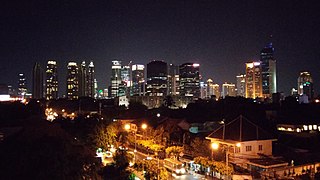
Tanah Abang is a district of Central Jakarta, Indonesia. The district hosts the biggest textile market in Southeast Asia, Tanah Abang Market. It hosts Bung Karno Stadium, in Kelurahan Gelora, and the western half of the largely skyscraper-dominated Sudirman Central Business District.
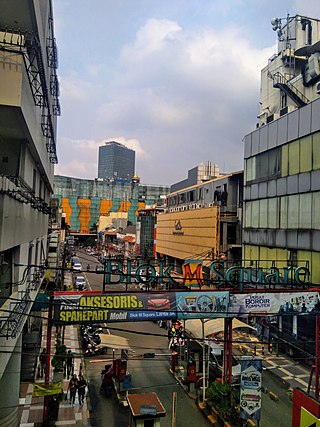
Blok M is a business and shopping quarter located in Kebayoran Baru, South Jakarta, Indonesia. It runs east from Iskandarsyah street to Bulungan street in the west. North from Falatehan street to Melawai street in the south. The development is similar to some developments near Kota, West Jakarta. On a daily basis, crowds of people throng its street, and even more so during nighttime. Much of the popularity of the quarter is due to the prices of goods, and the nightlife.

Pondok Indah is an upscale residential area in Pondok Pinang, Kebayoran Lama, South Jakarta, Indonesia. It is one of the most prestigious suburb areas in Jakarta, and even in Indonesia. Pondok Indah is a much sought-after suburb by expatriates, conglomerates, celebrities, and government officials.

Kebayoran Baru is a district in the administrative city of South Jakarta, Indonesia. The name was derived from a planned satellite city of the same name which was developed in the post-war period. Kebayoran Baru was the last residential area to be developed by the Dutch colonial administration. The urban planning was laid in a concept of the Garden city movement, consisting of a well-planned residential area, a shopping center, and a business district, supported with civic facilities such as schools, places of worship, hospitals, and parks. Today, the district is home to many important government institutions, such as the Indonesia Stock Exchange building, the ASEAN Headquarters building, the National Police headquarters, and the City Hall of South Jakarta. Sudirman Central Business District is also located in the district.
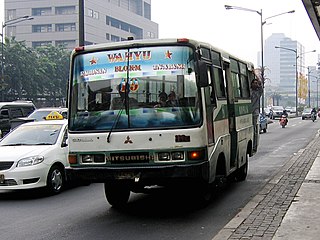
Koperasi Angkutan Jakarta or Kopaja was a cooperative established in 1971 to provide public transport services in Jakarta. There were reportedly over 1,400 minibuses in the Kopaja fleet in mid-2012, more than half of which were estimated to be over 20 years old.
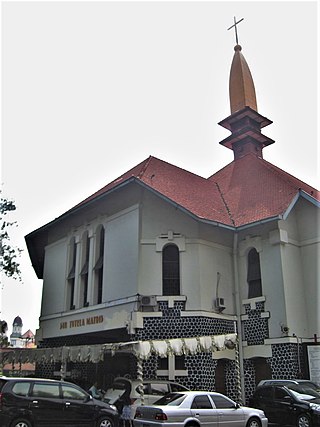
The Cathedral of the Virgin Mary, Queen of the Holy Rosary, also known as the Holy Rosary Cathedral or Randusari Cathedral, is a Roman Catholic cathedral and the seat of the Archdiocese of Semarang. Finished in 1927 at Randusari, Semarang, Indonesia, it became a parish church in 1930 and a cathedral in 1940, when Albertus Soegijapranata was made the first archbishop of Semarang.

Jalan M.H. Thamrin or Jalan Thamrin is a major thoroughfare in Jakarta, Indonesia. The road is located at the center of Jakarta, running from the north end of Jalan Jenderal Sudirman at West Flood Canal at the south end to the roundabout near Arjuna Wijaya Statue Jakarta at the north end. Developed in the 1950s, the road was a landmark of post-colonial Indonesia and continues to have a prominent importance in Jakarta.

St. Joseph's Church, also known as Gedangan Church, is a Catholic church in Semarang, Indonesia, the first such church in the city. Administratively, it is part of the St. Joseph's Parish in the Archdiocese of Semarang.

Medan Cathedral is a Roman Catholic Cathedral in Medan, Indonesia. The current cathedral was inaugurated in 1928. It is one of the Dutch colonial buildings in Medan.

Pasar Minggu Station (PSM) is a railway station in Pasar Minggu, Pasar Minggu, South Jakarta. The station, which is located at an altitude of +36 meters, is included in the Operation Area I Jakarta and only serves the KRL Commuterline route.

Pasar Minggu Baru Station (PSMB) is a railway station in East Pejaten, Pasar Minggu, South Jakarta, Indonesia. The station, which is located at an altitude of + 29 metres, is included in the Jakarta Operational Area I and only serves the KRL Commuterline route.
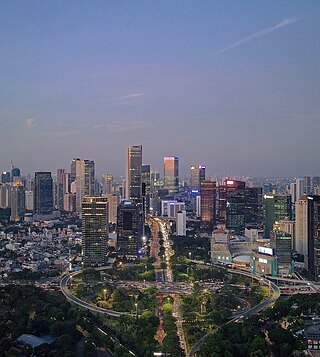
Semanggi Interchange or commonly known as Semanggi Bridge is a major road interchange in Jakarta, Indonesia which consists of a cloverleaf interchange —the first, and until the 1990s the only, of its kind in Indonesia—and a partial turbine interchange. Two main roads of the city Gatot Subroto Road and Sudirman Road intersect at this interchange. Initially completed in 1962 as part of several projects intended to be completed before the 1962 Asian Games, the interchange is a landmark and an important part of the Golden Triangle of Jakarta.

Mayestik Market is a modern traditional market at Kebayoran Baru, in Jakarta, Indonesia. Drugs and cosmetics, jewelry, clothing and tailors, vegetables and fruits, meat and fish, book store, sports equipment, almost everything needed for daily life are available in this market.

Hilman Djajadiningrat was an Indonesian aristocrat and politician.

Blok M MRT Station is a rapid transit station on the North-South Line of the Jakarta MRT in Jakarta, Indonesia. The station is located on Jalan Panglima Polim Raya, Melawai, Kebayoran Baru, South Jakarta, between ASEAN and Blok A stations. Unlike other stations on the MRT network, it has three tracks, with two island platforms.
Mgr. Theodorus Lumanauw was archbishop of Ujung Pandang from 7 August 1973 until his death in office on 18 May 1981.

Transjakarta Corridor 13 is a bus rapid transit corridor in Greater Jakarta, Indonesia, operated by Transjakarta. It serves the route from Ciledug, Tangerang, Banten, to Tegal Mampang BRT station in Mampang Prapatan, South Jakarta. The roads traversed by Corridor 13 are HOS Tjokroaminoto (Tangerang), Ciledug Raya, Kebayoran Lama, Kyai Maja, Trunojoyo, Wolter Monginsidi, and Kapten Tendean. This is the first corridor on the BRT system to operate on a separated elevated route, running via a 9 kilometre long and 8 metre wide dedicated elevated bus lane, with height ranging from 18 to 23 metres above ground level.




















